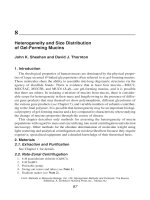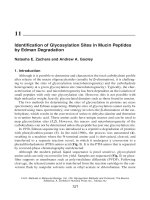Glycoprotein methods protocols - biotechnology 048-9-087-096.pdf
Bạn đang xem bản rút gọn của tài liệu. Xem và tải ngay bản đầy đủ của tài liệu tại đây (126.56 KB, 10 trang )
Heterogeneity and Size Distribution of Gel-Forming Mucins 87
87
From:
Methods in Molecular Biology, Vol. 125: Glycoprotein Methods and Protocols: The Mucins
Edited by: A. Corfield © Humana Press Inc., Totowa, NJ
Heterogeneity and Size Distribution
of Gel-Forming Mucins
John K. Sheehan and David J. Thornton
1. Introduction
The rheological properties of human mucus are dominated by the physical proper-
ties of large secreted O-linked glycoproteins often referred to as gel-forming mucins.
These molecules share the ability to assemble into long oligomeric structures via the
agency of disulfide bonds. There is evidence that at least four mucins—MUC2,
MUC5AC, MUC5B, and MUC6 (1–4)—are gel-forming mucins, and it is possible
that there are others. In isolating a mixture of mucins from mucus, there is consider-
able scope for heterogeneity in their mass and length owing to the presence of differ-
ent gene products that may themselves show polymorphism, different glycoforms of
the various gene products (see Chapter 7), and variable numbers of subunits contribut-
ing to the final polymer. It is possible that heterogeneity may be an important biologi-
cal property of gel-forming mucins and a key comparative characteristic when studying
the change of mucous properties through the course of disease.
This chapter describes only methods for assessing the heterogeneity of mucin
populations with regard to mass and size utilizing rate zonal centrifugation and electron
microscopy. Other methods for the absolute determination of molecular weight using
light scattering and analytical centrifugation are not described here because they require
expensive, specialized equipment and a detailed knowledge of their theoretical basis.
2. Materials
2.1. Extraction and Purification
See Chapter 1 for details.
2.2. Rate-Zonal Centrifugation
1. 6 M guanidinium chloride (GuHCl).
2. 8 M GuHCl.
3. Peristaltic pump.
4. Swing-out rotors and tubes (see Note 1).
5. Gradient maker (see Note 2).
8
88 Sheehan and Thornton
6. Magnetic stirrer.
7. Thin glass capillaries (approx 10 cm).
8. Hamilton syringe (100–500 µL).
2.3. Electron Microscopy
2.3.1. Spreading Experiments
1. Spreading agent: 100 µg/mL of benzyldimethylalkylammonium chloride (BAC).
2. Spreading solution: 10 mM magnesium acetate (see Note 3).
3. Staining solution: ethanolic uranyl acetate. This is prepared by making a saturated solu-
tion of uranyl acetate in 0.1 M HCl and then spinning in a benchtop centrifuge for 5 min.
Take 50 µL of the supernatant and make to 1 mL with ethanol.
4. Mica squares (2 × 2 cm).
5. Forceps.
6. Grids (400–600 mesh).
7. Platinum wire (0.2 mm diameter).
8. Rubber O-rings (2 cm diameter).
9. Teflon trough or small plastic Petri dish (approx vol 10 mL).
10. 95% (v/v) ethanol.
11. Liquid nitrogen.
12. 0.1 M acetic acid.
13. Carbon rods.
14. Vacuum-coating unit.
2.3.2 Replicas
1. Reagents as for Subheading 2.3.1.
3. Methods
3.1. Extraction and Purification
For a detailed description, see Chapter 1.
3.2. Rate-Zonal Centrifugation
Because of their extreme size, most gel chromatographic media are not useful for
studying size distribution of intact mucins. A useful alternative, however, is rate-zonal
centrifugation, which separates molecules not on hydrodynamic volume alone but on
their mass-to-volume ratio as well. The basis of rate-zonal centrifugation for this pur-
pose is long established and, in its simplest form, is the overlaying of a small volume
of sample onto preformed gradient of a supporting medium of increasing density. The
sample is centrifuged and a separation of different species in the mixture is effected on
the basis of their sedimentation rates. The role of the preformed gradient is to provide
a stable, supporting medium resistant to convective disturbances that are caused by
temperature and mechanical instabilities in centrifuges.
We first demonstrated the value of rate-zonal centrifugation for the characteriza-
tion of cervical mucin heterogeneity and polydispersity (5) and have since used this
method to analyze the gel-forming mucins from a range of different epithelia and cell
cultures (6,7). We typically use 6–8 M guanidinium chloride (see Note 4) as the gradi-
ent support medium, and mucins have been shown to have (for certain rotor geom-
etries) isokinetic sedimentation behavior in this system (see Note 5).
Heterogeneity and Size Distribution of Gel-Forming Mucins 89
We next describe an experiment that involves the simultaneous preparation of
3 × 12 mL (in 13-mL tubes) 6–8 M GuHCl gradients (Fig. 1), their subsequent centrifu-
gation in a Beckman (Fullerton, CA) SW 40Ti swing-out rotor, and finally unloading
and analysis of the tube contents.
1. Measure out 18 mL of 6 M GuHCl into one chamber of the gradient maker and an equal
volume of 8 M GuHCl into the other chamber (see Note 2).
2. Mix contents of 6 M GuHCl chamber with a magnetic stirrer and open tap.
3. Pump contents of gradient maker into the bottom of three centrifuge tubes (in this case
13-mL tubes) at a flow rate of approx 1.3 mL/min/tube (see Note 6).
4. Weigh tubes to check that they contain equal volumes.
5. Carefully apply sample (up to 500 µL) with a Hamilton syringe to the top of the gradient
(see Note 7).
6. Centrifuge at 40,000 rpm (Beckman SW 40 Ti swing-out rotor) for desired time at 15°C
(in our case 2.5 h) (see Note 8).
7. Unload tubes from the top with a pipet (for a gradient of this volume we usually take
0.5-mL fractions).
8. Analyze fractions with a general carbohydrate assay (e.g., Periodic acid-Schiff) and
for lectin and antibody reactivity (see ref. 8 for detailed procedures). The GuHCl
concentration can be determined by measuring the refractive index of each fraction
(see Note 9).
9. Figure 2 shows an example of the data obtained from a respiratory mucin preparation.
Fig. 1. Schematic diagram of gradient-forming apparatus.
90 Sheehan and Thornton
3.3. Electron Microscopy
Electron microscopy has been used to study the size, shape, and structure of both
the intact mucins and their subunits (9). In addition, it can be used to identify the
presence of specific epitopes or structural domains (10). Two methods for preparing
mucins for electron microscopic analysis are described: monolayer spreading (adapted
directly from the study of DNA) and replica shadowing (commonly used for high-
resolution imaging of all types of biomolecules). Rigorous purification of the mucins
prior to electron microscopy is essential since lipids and globular proteins interfere
with spreading experiments and DNA could be mistaken for the mucins.
3.3.1. Spreading Experiments
Three steps underlie the application of the monolayer method as applied to mucins:
the preparation of thin, strong, carbon support films on grids; the deposition of the
Fig. 2. Rate-zonal centrifugation of respiratory mucous extract. A respiratory mucous extract
in 4 M GuHCl was applied to a 6–8 M GuHCl gradient (12 mL) and centrifuged at 202,000 g
average (40,000 rpm) for 2.5 h at 15°C in a Beckman SW40 Ti swing-out rotor. The gradient
was emptied from the top into 0.5-mL fractions, and these were analyzed for reactivity with
antisera for the MUC5AC (
᭹
) and MUC5B (
᭺
) mucins. The MUC5B mucin is more polydis-
perse than the MUC5AC mucin and has molecules of an apparent higher molecular size. The
arrow denotes the position of sedimentation of the reduced MUC5AC and MUC5B mucins
centrifuged under these conditions. The reduced subunits of these mucins can be separated by
centrifugation for a longer time (approx 7 to 8 h).
Heterogeneity and Size Distribution of Gel-Forming Mucins 91
mucins on these grids; and the addition of contrast, including positive staining and/or
metal shadowing.
3.3.1.1. P
REPARATION OF
C
ARBON
-C
OATED
G
RIDS
1. Prepare a thin carbon film (2–5 nm) by the indirect evaporation of carbon onto 2-cm
2
blocks of freshly cleaved mica (Fig. 3).
2. Leave the mica in a water-saturated environment for approx 1 h.
3. Place 15–25 EM grids at the bottom of a water-filled Petri dish on a wire mesh.
4. Remove the film from the mica by floating it off on the surface of the water-filled dish.
5. Gently lower a rubber O-ring onto the floating carbon film. This allows the intact film to
be steered on the water surface over the grids.
6. Lower the water level by gentle suction to allow the carbon film to be deposited on the grids.
7. Dry the grids in an oven at 60°C for 2 h.
3.3.1.2. D
EPOSITION OF
M
UCINS ON
G
RIDS
The spreading method was originally developed by Kleinschmidt (10a) using cyto-
chrome C as the spreading agent and was subsequently developed by others (11). We
describe here a modified method first reported for the improved imaging and analysis
of DNA (12). The basis of the method is the creation of a monolayer in which the long
filamentous molecules are gently entrapped and thereafter can be removed onto the
Fig. 3. Schematic diagram of spreading method. A solution of mucins (typically about
10 mL) at a concentration of 0.01–0.1 µg/mL in any aqueous solvent is poured into a Teflon
trough. A drop (1 µL) of a solution of BAC (100 µg/mL) is touched to the surface and the
solution is left for 5–15 min. In this time the mucins diffuse to the surface and become entrapped
in the BAC monolayer. A carbon-coated electron microscope grid (400–600 mesh) is touched
to the surface and thereafter washed in 95% ethanol, dried, and rotary shadowed. This can also
be performed in a microversion by adding the BAC to the mucin in solution and transferring
40-µL drops to a Teflon surface. Within minutes the BAC forms a monolayer on the solution
surface, where the mucin molecules become trapped. The surface film is touched to the carbon-
coated grid as described previously.









